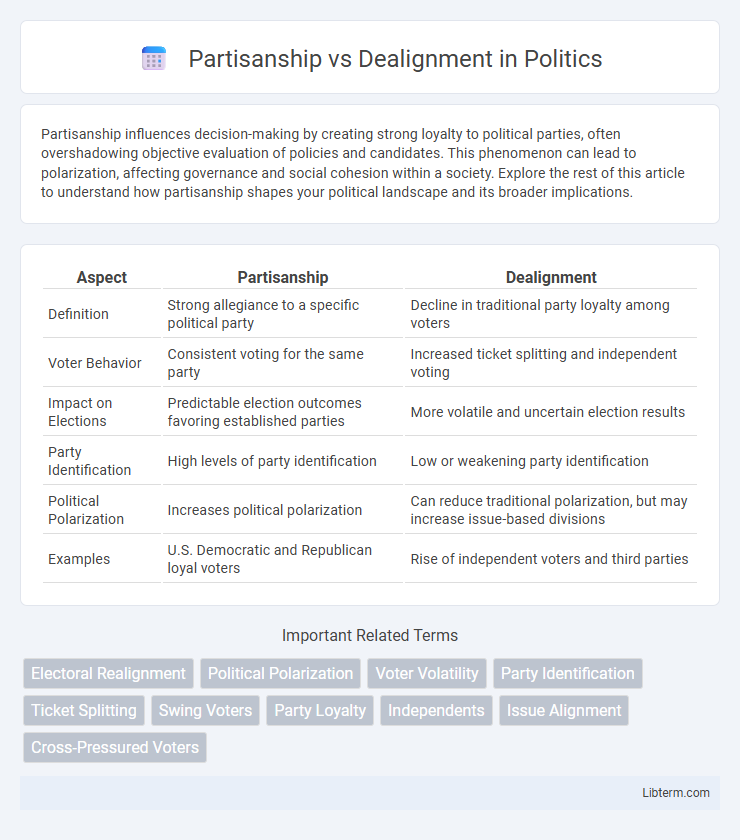Partisanship influences decision-making by creating strong loyalty to political parties, often overshadowing objective evaluation of policies and candidates. This phenomenon can lead to polarization, affecting governance and social cohesion within a society. Explore the rest of this article to understand how partisanship shapes your political landscape and its broader implications.
Table of Comparison
| Aspect | Partisanship | Dealignment |
|---|---|---|
| Definition | Strong allegiance to a specific political party | Decline in traditional party loyalty among voters |
| Voter Behavior | Consistent voting for the same party | Increased ticket splitting and independent voting |
| Impact on Elections | Predictable election outcomes favoring established parties | More volatile and uncertain election results |
| Party Identification | High levels of party identification | Low or weakening party identification |
| Political Polarization | Increases political polarization | Can reduce traditional polarization, but may increase issue-based divisions |
| Examples | U.S. Democratic and Republican loyal voters | Rise of independent voters and third parties |
Understanding Partisanship: Definition and Historical Context
Partisanship refers to strong loyalty or support for a specific political party, often influencing voter behavior and political identity. Historically, partisanship has shaped electoral dynamics by creating clear party alignments and fostering consistent voting patterns throughout major political events such as the New Deal era and post-World War II realignments. Understanding partisanship requires examining its role in stabilizing party systems and reinforcing ideological divides within democracies.
The Rise of Dealignment: What Does It Mean?
The rise of dealignment signifies a decline in traditional party loyalty as voters increasingly identify as independents or switch allegiances based on specific issues rather than long-term party affiliation. This trend reflects growing political polarization and dissatisfaction with established parties, leading to unpredictable election outcomes and challenges in forming stable governance. Dealignment reshapes democratic engagement by emphasizing candidate appeal and issue-based campaigning over partisan loyalty.
Key Differences Between Partisanship and Dealignment
Partisanship refers to strong, consistent support for a particular political party, often influenced by long-term affiliations and ideological loyalty. Dealignment, on the other hand, involves a decline in party identification, where voters become more independent or switch support frequently, reflecting decreased influence of traditional party ties. The key differences lie in stability and voter behavior: partisanship highlights entrenched party loyalty, while dealignment emphasizes fluidity and weakening party influence in electoral politics.
Factors Driving Partisan Loyalty
Factors driving partisan loyalty include social identity, political socialization, and issue alignment, which deeply influence voter behavior and attachment to political parties. Demographic variables such as age, ethnicity, and socioeconomic status play a critical role in sustaining partisanship over generations. Psychological commitment to party ideology and perceived party performance also maintain strong partisan bonds despite shifting political landscapes and emerging dealignment trends.
Causes and Indicators of Voter Dealignment
Voter dealignment is primarily caused by growing political disenchantment, declining party loyalty, and the rise of individual candidate appeal over traditional party affiliation. Indicators of dealignment include increased volatility in election results, higher rates of split-ticket voting, and a significant rise in independent or undecided voters. The erosion of strong partisan identities reflects shifting voter priorities and a fragmented political landscape.
Impacts on Electoral Outcomes and Political Stability
Partisanship strengthens voter loyalty and simplifies electoral predictions by creating consistent support for political parties, often resulting in stable government majorities and policy continuity. Dealignment, characterized by declining party identification and rising independent voters, leads to unpredictable electoral outcomes, increased volatility, and fragmented legislatures, challenging political stability. Shifts from strong partisanship to dealignment can weaken institutional trust and increase electoral competition, impacting governance effectiveness and long-term political cohesion.
Influence of Media and Information Ecosystem
Media and the evolving information ecosystem significantly shape partisanship by amplifying selective exposure and reinforcing ideological biases, leading to intensified political identities. In contrast, dealignment emerges as media fragmentation and information overload foster skepticism and reduce voter loyalty to traditional parties. The rise of social media platforms and algorithm-driven content exacerbates echo chambers, simultaneously deepening partisanship and promoting political disengagement among diverse audiences.
Social and Demographic Shifts Shaping Trends
Social and demographic shifts such as urbanization, increased educational attainment, and greater racial and ethnic diversity are driving dealignment by weakening traditional party loyalties. Younger generations exhibit more fluid political preferences compared to older cohorts, contributing to fluctuating partisan identification. Migration patterns and changes in family structure also reshape social networks and influence individual political behavior, intensifying the trend toward dealignment.
Global Perspectives: Partisanship and Dealignment Worldwide
Global perspectives on partisanship and dealignment reveal diverse political dynamics shaped by historical, cultural, and socio-economic factors. Countries like the United States and United Kingdom show fluctuating partisan loyalty influenced by polarization and identity politics, while many European democracies experience dealignment due to voter dissatisfaction with traditional parties and the rise of populist movements. Emerging democracies in regions such as Latin America and Africa exhibit varying degrees of partisanship, often challenged by political instability and evolving party systems.
Future Implications for Democracy and Governance
Partisanship fosters strong political identities that can enhance voter engagement but may lead to polarization, hindering effective governance and policy compromise. Dealignment, characterized by weaker party loyalties, encourages more flexible voter behavior and opportunities for new political movements, yet risks increasing political volatility and instability. The future of democracy hinges on balancing these dynamics to maintain robust citizen participation while ensuring effective, stable governance structures.
Partisanship Infographic

 libterm.com
libterm.com